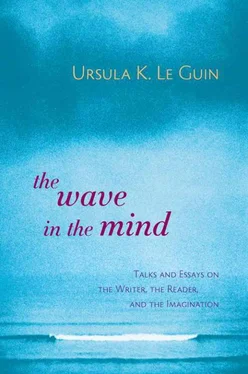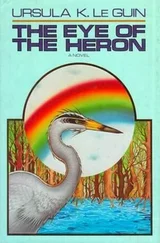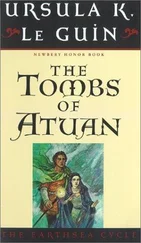Paul has reacted to her as to a beautiful woman, but Virginia feels “dirtied” by even this contact with an Underperson. At the end, high on the ruined boulevard in the sky, C’mell tries again to save them both. Virginia, horrified that a cat-girl might actually touch her, tries to avoid her and falls to her death. Only Paul, who saw her as human, can be saved. And the reason she wanted to save them was that Paul—unthinkingly, instinctively—had stopped another man from crushing the eggs of some birds.
You saved them. You saved their young, when the red-topped man was killing them all. All of us have been worried about what you true people would do to us when you were free. We found out. Some of you are bad and kill other kinds of life. Others of you are good and protect life.
Thought I, is that all there is to good and bad?
There is, of course, much more to the story, a marvelously complex one; but at the heart of it is this motif, a familiar one from our secular mythology, our folktales. The girl who saves the ant from the spider’s web is saved in turn by the ants, who do her impossible task for her; the prince who sneers at the wolf in the trap is lost in the forest, but the prince who frees the wolf inherits the kingdom. The theme is pagan, entering Christianity only with St. Francis. It is a profound element of Buddhism, Jainism, and other Asian religions; and the sense of the interdependence of human and animal is fundamental to the native religions of North America.
Smith was touching a deep chord here, one that is not often struck in realistic fiction. Science fiction is specifically suited to this theme, since its central subject is the interaction of the human with the nonhuman, the known/self with the unknown/other. The durable and mysterious power of Cordwainer Smith’s stories is not a matter only of their exuberant language and brilliant invention and hallucinatory imagery; there is a deep ground to them, a moral ground, lying in his persuasive conviction of the responsibility of one being for another. “Thought I, is that all there is to good and bad? ”
Note: Cordwainer Smith’s works, published in paperback, are at any given moment mostly out of print. Among them are the story collections You Will Never Be the Same, Space Lords, Stardreamer , and various combinations of pieces of what never quite became a finished novel, published under the titles The Planet Buyer, Quest of the Three Worlds , and Norstrilia.
STRESS-RHYTHM IN POETRY AND PROSE
This investigation and discussion grew out of a workshop on rhythm in language I gave in 1995. It leads to the next essay, on rhythm in Tolkien’s work.
GETTING THE BEAT
RHYTHM Phys., Physiol., etc ., movement with regular succession of strong and weak elements; regularly recurring sequence of events.— In literature , metrical movement determined by various relations of long and short or accented and unaccented syllables; measured flow of words and phrases in verse or prose. In music , periodical accent and the duration of notes. In fine arts , harmonious correlation of parts; regular succession of opposites. ( The Concise Oxford Dictionary )
Movement is the first word. Rhythm is a mode of time.
Like time, rhythm can be imagined as linear, events seen as beads strung along a line of intervals, or cyclical: the line becomes a circle, a necklace of beads. Or if the event is singular, the interval can be seen as a circle always coming round to it again: for instance, year as interval, birthday as event….
Identical intervals make a regular rhythm. The more irregular the intervals are, the more alike the events have to be for any rhythm to be recognised.
Rhythm is a physical, material, bodily thing: the drumstick hitting the drumhead, the dancer’s pounding feet. Rhythm is a spiritual thing: the drummer’s ecstasy, the dancer’s joy.
Beginning to consider the rhythms of writing, my mind wandered about among the world’s beats: the clock, the heart, the interval between the last meal and the next meal, the alternation of day and night. Trying to understand how and why writing is rhythmical, I thought about mechanical, biological, social, and cosmic rhythms; about the interplay of bodily rhythms with social regularities; about the relation of rhythm and order, rhythm and chaos.
One way to start thinking about such things is to try to listen to your own body’s beat.
Many kinds of meditation begin, and some go on, by concentrating your awareness on breathing, nothing but breathing. You sit and you pay attention, full attention, constant attention, to your breath as it goes in your nostrils and comes out. When your attention wanders, you gently bring it back to your nose and the sensation of breathing. In… out… in… out… To sit and be fully aware of the air going in and out of your nose and nothing else, this sounds really stupid. If you haven’t tried it, try it. It is really stupid. Nothing your intellect can do can help you do it. This must be why so many people for so long have used it as a way towards wisdom.
Rhythm is pulsation. So is life. If they want to know if you’re still alive, they feel for your pulse, no? Find your pulse where you can feel it easily and attend to it, its evenness and irregularities. Heartbeat changes a lot, it’s seldom metronomically even for long.
And also, attend to the interval between beats, thinking of the pulse as a boundary between intervals. Event and interval, like figure and ground, can be reversed.
Walking is a lovely beat. Just walking. Runners like a fast pounding beat, a high stress-rate. That’s fine. But it’s also pleasant to walk, just walk, in awareness of the steady, subtle, ever-changing rhythms of walking.
T’ai chi walking is interestingly rhythmical. I learned to do it thus: You’re barefoot. You stand still for a while. On an inbreath, lift one foot and move it forward. Set it down as you breathe out. The other foot will naturally begin to rise, but its full rise and movement forward must wait for the inbreath. It comes softly down on the outbreath. Meanwhile, the first foot is ready for the inbreath…. You aren’t going to get very far, walking this way. I used to fall over quite a lot when I first tried it. To keep your balance it helps to set the whole foot down at once, lightly, not striking down heel first, and to be aware of the touch of foot on ground and the touch of ground on foot. This is very low stress-rate walking. It’s a form of meditation, because you can’t think about anything else while doing it.
Meditation is a word often used to mean “thinking” but as I understand it, it means not thinking, which is much harder than one would think. In any case, all the meditative practices I know offer an immediate awareness of bodily and other rhythms.
RHYTHM IN LANGUAGE: STRESS
I apologise for the didactic tone of this section. The subject of language rhythms has a technical vocabulary, and as with all such jargons, some words need explaining. The technical word for the beat in language (spoken or written) is stress . There are unstressed languages, but English is a language that uses stress.
ENGlish is a LANGuage that Uses STRESS.
Some syllables get said harder than others. That’s “stress.”
Every English word spoken by itself has at least one stressed syllable, even if it only has one: (WHEN?) Many words, however, when used in sentences, receive no stress: the, of, in, a, when… (when USED in SENtences). In normal speech, a stress occurs every few syllables.
Читать дальше




